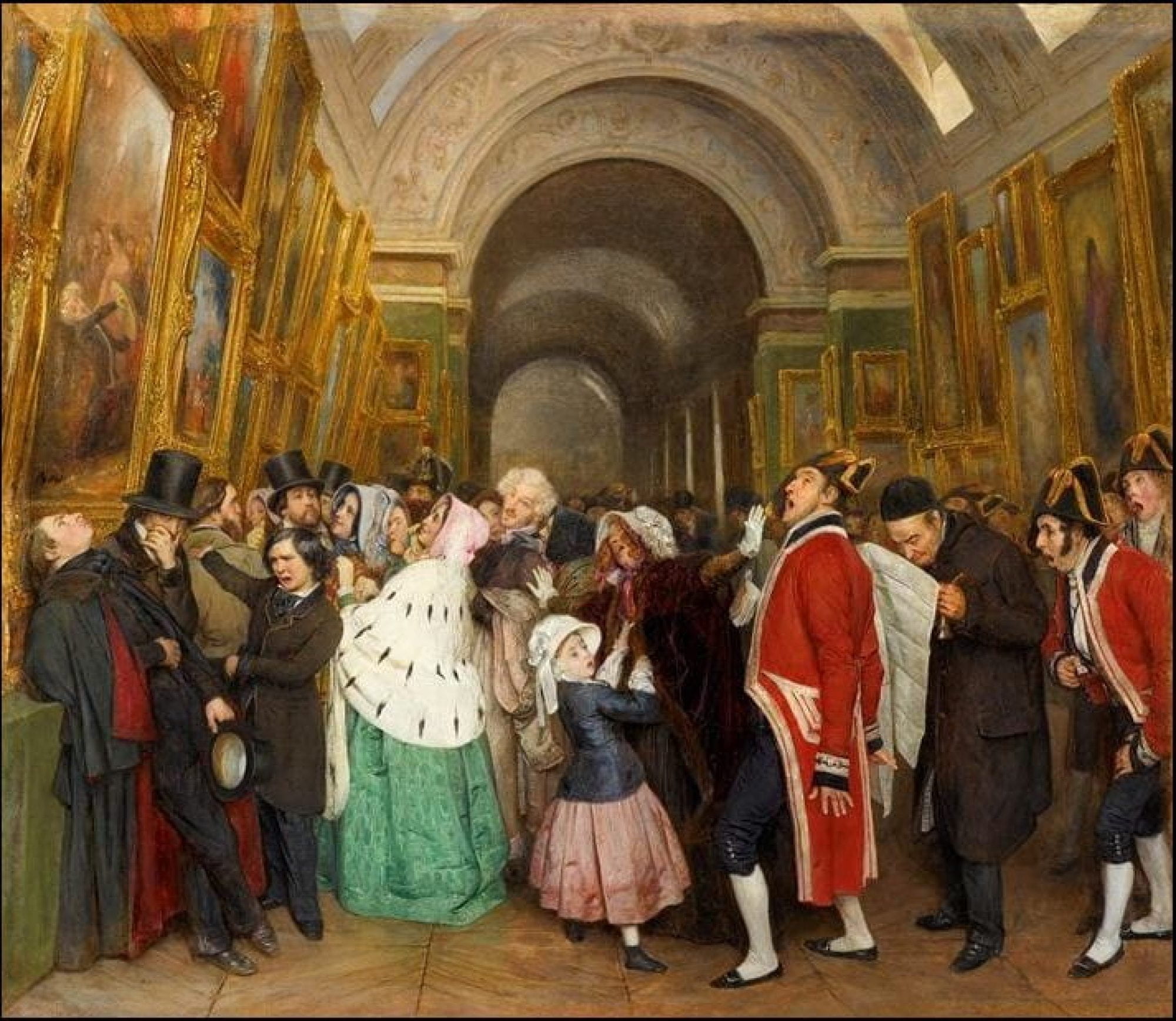There are Words in the Abstract: Arielle Austin at The Commerce Gallery, Lockhart, TX.
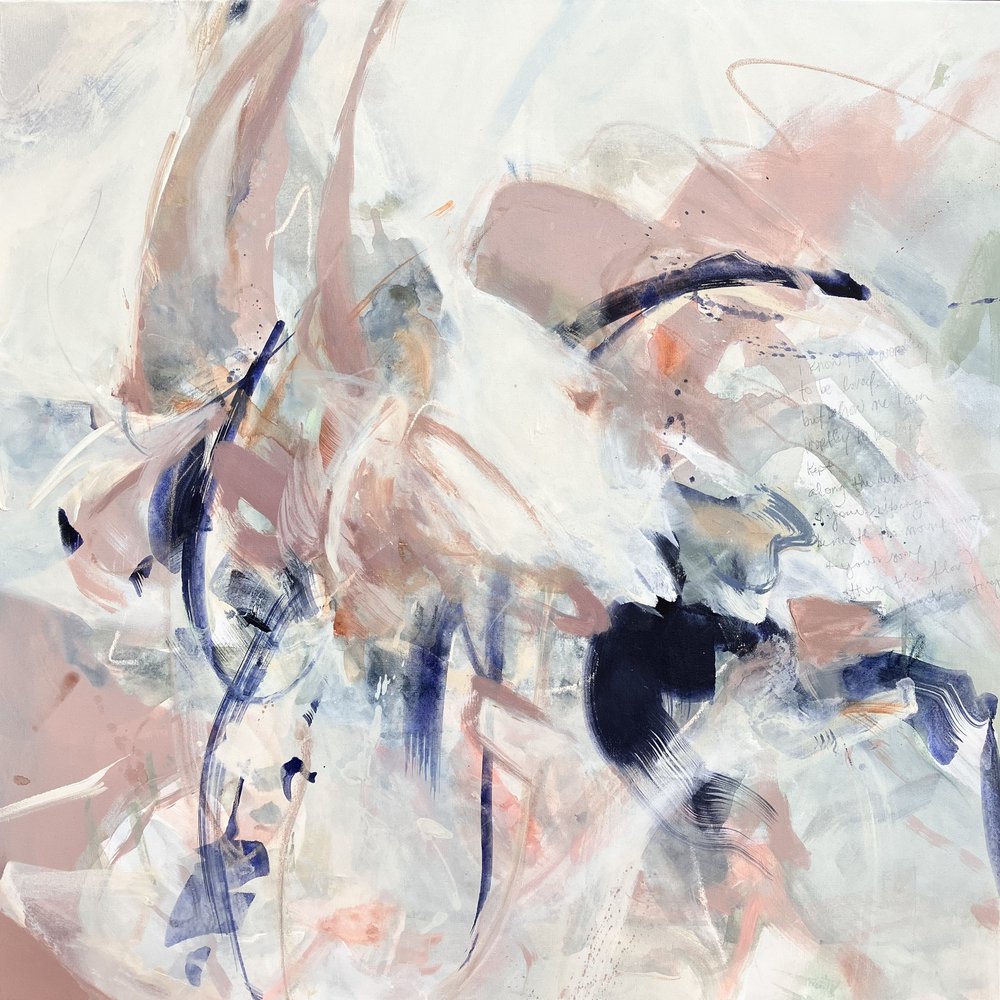 To Be Kept, acrylic, pastel, graphite on 36” x 36” canvas
To Be Kept, acrylic, pastel, graphite on 36” x 36” canvas
As a painter myself, I have an appreciation for abstract paintings. I see abstract paintings as aesthetically beautiful, and I also respect the technical skill they require. However, as an artist, it is not typically a style of painting that I resonate with personally, and I have always found trouble grasping meanings within them. I feel that analyzing abstract art requires a different effort than paintings with realistic forms or people. I feel as if my interpretation of the work can be incorrect, so I consider myself not the right person to evaluate this style of art. That was until I viewed Arielle Austin’s abstract paintings about self-love and spiritual healing.
When it came time for my friend and I to look for art shows and exhibitions, we knew that we should visit the Commerce Gallery in Lockhart, Texas. We had visited the gallery before for other class projects and always left inspired. When walking into their current exhibition, there hung Michael Van’s paintings to the right and the paintings of Arielle Austin on the left wall of the gallery, parallel to each other. I immediately looked to the work of Michael Van first, where he depicts scenes of something like a vacation, people enjoying time by rivers and by pools. I began to analyze what I specifically liked and my interpretation of his pieces. Van’s work was the style of painting I was much more familiar with and had done myself, so consequently they were where I gravitated in comparison to the abstract paintings on the other wall.
On the opposite side of the gallery hung a row of Austin’s paintings. While I was trying to come to the decision of whether to review Van’s paintings, my friend encouraged me to really look at the abstract paintings closer. My friend was right that Austin’s work was alluring all together in a row. So, I turned around and walked up to the first and second paintings of Austin’s exhibition. I was looking at To Be Kept, a 36 x 36-inch acrylic, pastel painting and I made a discovery that compelled me to call out to my friend. “There are word in the abstract?” I was referring to what looked like graphite pencil, a short, written passage hidden in the underpainting of the piece. We made an unsuccessful attempt to read some of the passage, only being able to recognize a few words such as “worthy” and “loved.” Reading these words to lose all the hesitance I had about reviewing abstract art. I immediately wanted to take an in-depth look at all the paintings and also learn more about Austin.
Austin is an artist based in Austin, Texas, and the collection of paintings that I had the pleasure of viewing were from her From Prose to Poetry (2023) exhibition. The exhibition captures her journey of healing through emotional health. I chose not to read about her own purpose behind the creation of the paintings until I analyzed and interpreted all of her paintings myself. What I appreciate about Austin’s artwork is that I could feel the concept and purpose of the work through how she crafted her mixed-media paintings. Through the paintings you can explore her story on developing self-love, self-discovery, and healing.
How is it that her paintings actually feel like a journey to self-healing and spiritual growth? While looking at To Be Kept, you notice the colors first and how they work together to encourage the emotion. Austin paints a neutral greyish-blue tone in the background of the painting. In the foreground is a pink color that is sprawled across the canvas. A dark black-like, blue color appears only a few times, branching out from the pink. White is as heavily used as pink and in the places it appears, it overlaps with the other colors. You would think the way the colors sprawl across the canvas unrestrained would provoke the feeling of chaos, yet it does the complete opposite. The way Austin places these acrylic and pastel forms and brush strokes, conveys the feeling of searching. The accompanying prose is to the right edge of the painting:
“I know I am worthy to be loved but show me I am worthy to be kept along the curve of your ribcage beneath the mountains of your soul within the flow of your hearts beating.”
The painting is searching for what it is like to be more than just loved, what it is like to be kept. I see the dark blue color reaching out from the pink and white, that is the part to me that represents that longing. She knows she is worthy but wants more than that.
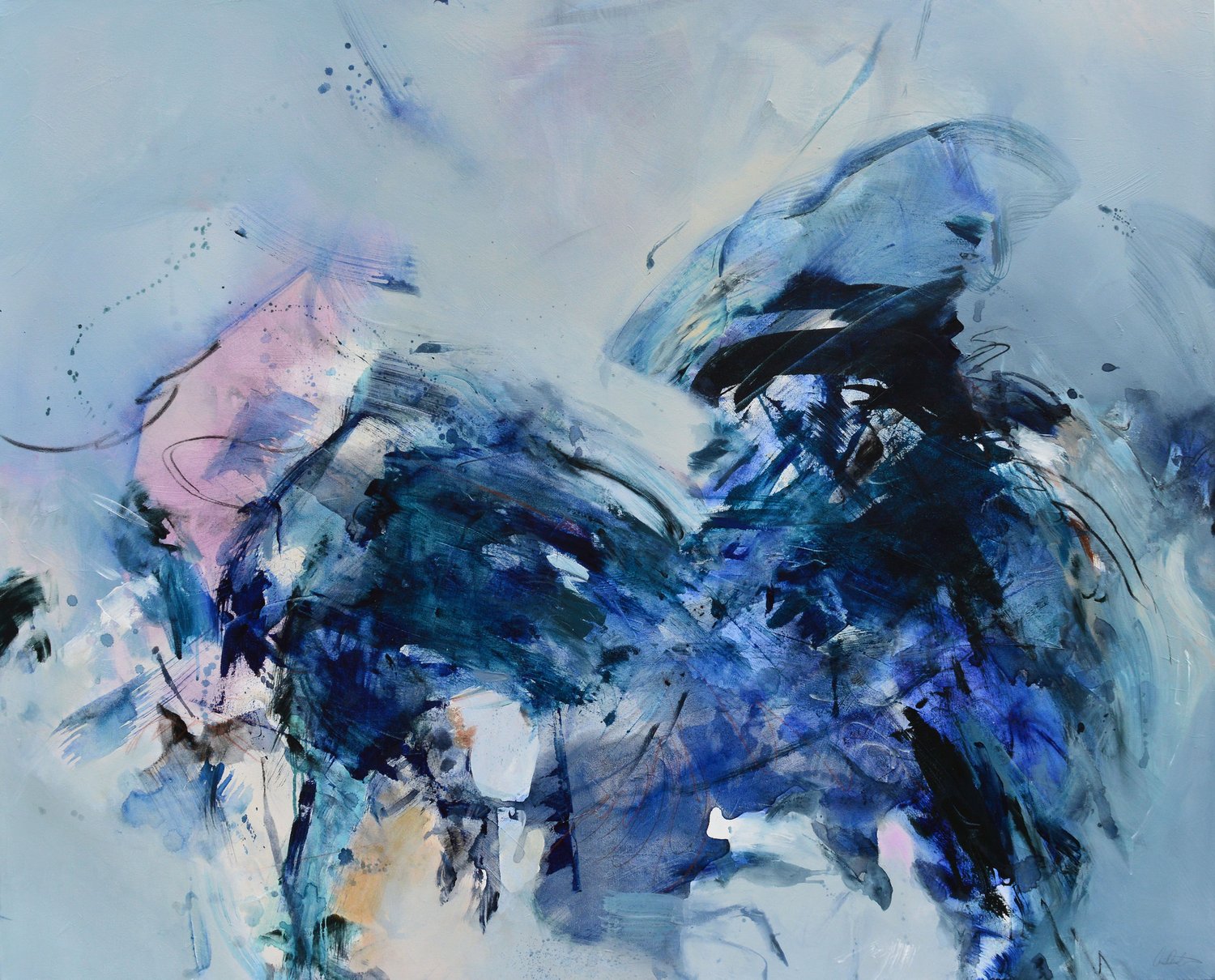 Bear With Me, acrylic, charcoal, wax pastel, pastel on 48” x 60” canvas
Bear With Me, acrylic, charcoal, wax pastel, pastel on 48” x 60” canvas
Some of her paintings do not have legible words such as Bear with Me, You Are my Sigh of Relief, Harlem, and In a Whisper. My favorite of these works is Bear with Me, the 48 x 60-inch acrylic, pastel, and charcoal piece caught my attention because of its blue color and because I was drawn to the large blue abstract form filling the center and bottom of the canvas. There are light burst of pink and orange colors in the background across the canvas. In the focus are brush and charcoal strokes, in a range of blue colors, tangle themselves and mesh together. You are unable to read the words hidden in this painting, but you can instead feel what is being said. The blue form fills the canvas and is almost heavy in weight like the pressure that mental illness can have. The tangled charcoal strokes convey the feeling of anxiety and depression. Bear With Me conveys to me the feeling of mental overwhelm. She is asking for patience while allowing all of her jumbled thoughts to undo themselves on the canvas. She is going through her pain.
While still viewing the Commerce Gallery, I wanted to read about Austin and why she curated this exhibition. She speaks about wanting to blog and share her feelings during challenging times as a way to navigate the journey of healing, and when her mental space worsened she represented it in paintings instead. I found myself moved by Austin’s vulnerability. She was able to find comfort in releasing her emotions out onto the canvas. It is constructive to be able to process and manage emotions in a way that allows you to turn pain into something beautiful. The process of painting can be therapeutic for many, but she goes further in using it to display her emotions during the path the healing. Spiritual journeys and finding self-love is rarely a direct, consistent path and her work conveys that.
As I continued to analyze Austin’s paintings, I found myself wondering if I needed and relied on the accompanying poetry to understand her work. Of course, poetry is part of her concept and is intentional, but I am curious as to if I would still feel the same newfound confidence in critiquing abstract art without any text. Must artwork be able to convey meaning on its own? I realize this is much of the argument surrounding abstract art and the reason as to why I have always avoided critiquing this style. Many people, including myself, had come to the assumption that the only way to grasp the message within an abstract piece, you must pull evidence from an external source. Researching the artist, reading their own personal statements about the piece or exhibition, or even reading the titles of the piece can give you an understanding of what you are viewing. In this case I was reading the prose in Austin’s paintings, and then I felt like I understood the messages in her exhibition.
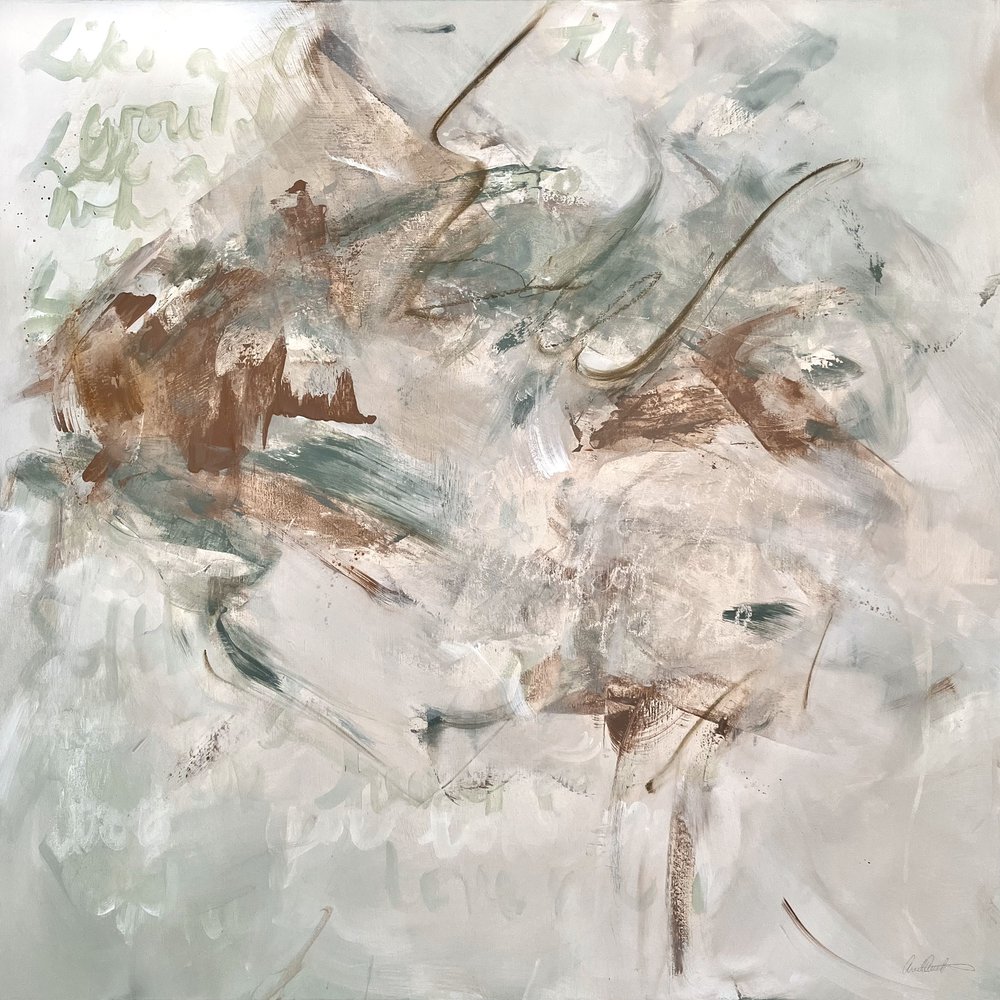 In A Whisper, acrylic, pastel on 36” x 36” canvas
In A Whisper, acrylic, pastel on 36” x 36” canvas
Though I agree that I used to rely on outside research to understand abstract art, the purpose and the power of abstract artwork is that it is completely expressive and meant to be viewed in a more emotional way. In many cases realistic and definitive subjects in artwork provide you with a clear message simply within the canvas. Even then there is still a level of imagination and personal interpretation that the viewers must provide when analyzing piece. Abstract art goes beyond realistic representation. It forces the viewers to seek out every characteristic about the painting in order to determine the meaning. It creates an emotional relationship between the art and the viewer. I have to rely on my own perception and make sensory connections through a process of thinking. To agree that the only reason I understand Austin’s artwork is because she includes poetry with it, I would be undermining that fact that her abstract work is about expression and has the power to convey meaning without any accompanying explanation.
That being said, I do feel that Austin’s combination of words and abstract is incredibly unique and make the paintings emotional. I would even say that the blend of words and abstraction makes her work feel human. All the words in the abstract are Austin’s own poetry. It is her own feelings, emotions, and the visual representation of it on the canvas is her own form of expression. Every aspect of the painting is completely personal and is in relation to another and works together to provide a visual and legible message. I believe that is what makes the exhibition effective, as if her paintings use both the left and right brain and make the art feel human. It creates a concentrated experience of the process of navigating human emotions. You are able to process her paintings through thinking analytically and emotionally. Her paintings that do not have hidden words are just as vocal as the works with it, but I can argue that the concept was successful and the perfect way to speak to viewers who may be experiencing negative mental health as well.
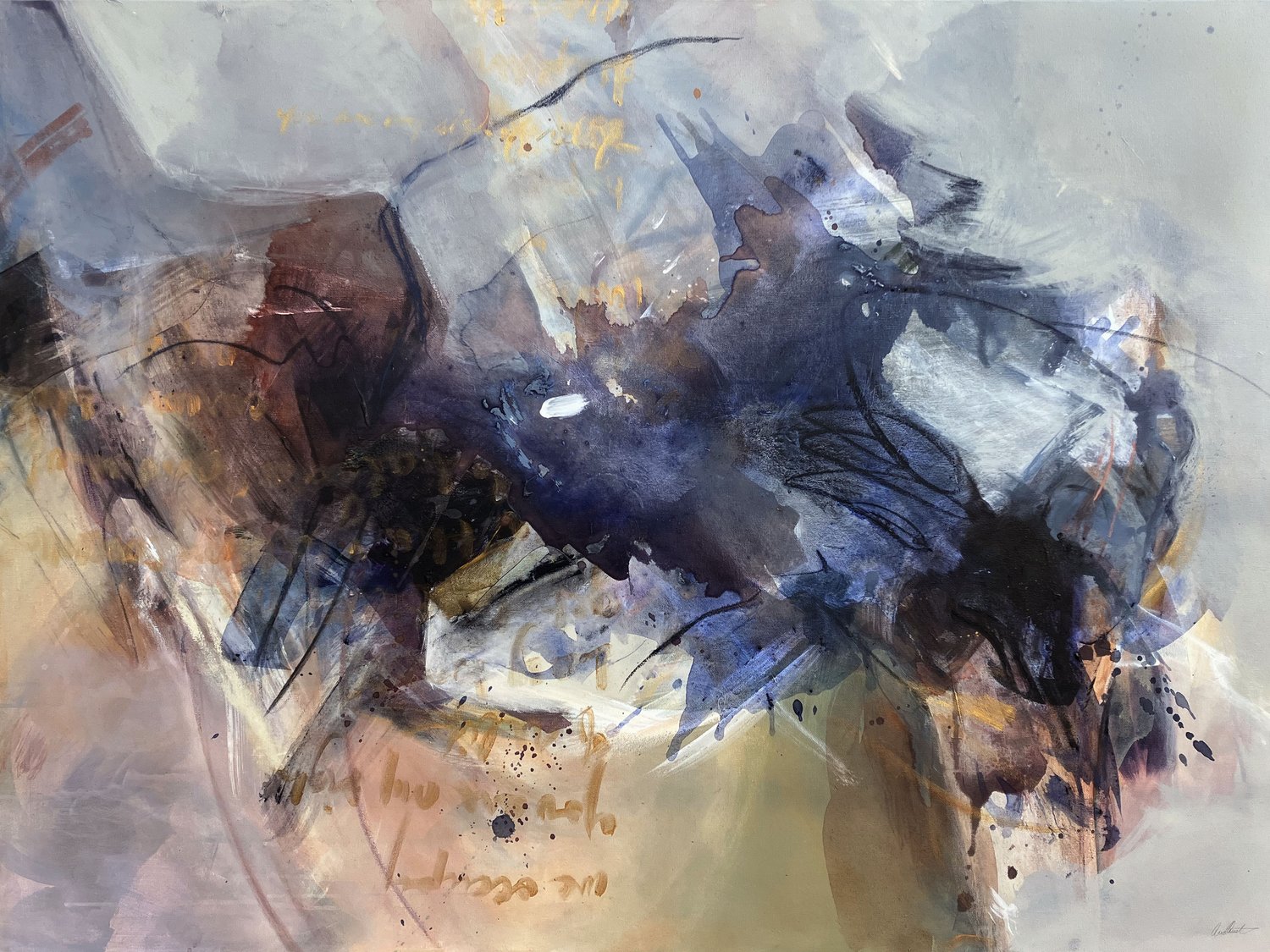 You Are My Sigh Of Relief, acrylic, pastel, charcoal on 36” x 48” canvas
You Are My Sigh Of Relief, acrylic, pastel, charcoal on 36” x 48” canvas
As I was leaving the Commerce Gallery, I left without the hesitation that I had arrived with about the critique of abstract artwork. Austin’s ability to beautifully connect poetry to visual abstraction, gave me the opportunity to look deeply into her individual pieces and the work as a whole and develop a connection to the story she is sharing through the works. As my friend and I began to talk about our own journey of healing from traumas and mental health, I realized just how abstract paintings can spark conversations not only between the viewer and the painting, but the viewer and the other people they interact with. Austin shares her own, individual self-love journey through her art, and yet she does it in a way that can also be a universal journey. Through her art people can share a connection, see the process of working through mental health, and be encouraged to process their own emotions. After viewing all of her paintings, you leave with something to think about or appreciate. I wonder now if there has always been words in the abstract, but I have never looked close enough to see it.
